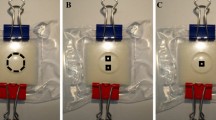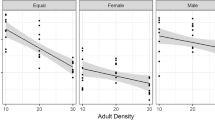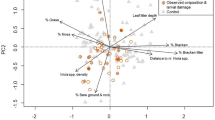Abstract
The ideal free distribution (IFD) predicts that individuals should be distributed between habitats in proportion to habitat suitability such that mean fitness is equal in each habitat. The IFD is useful in studies examining habitat selection, yet its key assumptions are often violated and the expected IFDs are not consistently detected. While the use of aggregation pheromones by insects is expected to evolve in systems that experience positive density dependence (Allee effect), through a series of experiments we test the hypothesis that aggregation pheromones may limit the ability of individuals to achieve an IFD. Using red flour beetles (Tribolium castaneum), we specifically test the prediction that beetles in groups with an equal sex ratio or in the presence of an artificial aggregation pheromone will deviate from an IFD, whereas female-only groups will achieve an IFD. We also test the hypothesis that aggregation pheromones evolved to promote Allee effects by testing the prediction that beetle fitness will show positive density dependence at low densities. Consistent with our first hypothesis, female groups achieved an IFD, while mixed sex groups and females in the presence of an aggregation pheromone in the low food habitat under-matched the IFD. We found no evidence of Allee effects at low density, but we did find evidence of strong negative density dependence. We demonstrate that the use of aggregation pheromones may negatively impact a population’s ability to achieve an IFD and cast doubt on the hypothesis that male aggregation pheromones evolve to promote Allee effects.


Similar content being viewed by others
References
Abrahams MV (1986) Patch choice under perceptual constraints: a cause for departures from an ideal free distribution. Behav Ecol Sociobiol 19:409–415
Allee WC, Emerson AE, Park O, Schmidt KP (1949) Principles of animal ecology. WB Saunder, Philedelphia
Åström M (1994) Travel cost and the ideal free distribution. Oikos 69:516–519
Boake CRB (1986) A method for testing adaptive hypotheses of mate choice. Am Nat 127:654–666
Bozdogan H (1987) Model selection and Akaike’s information criterion (AIC): the general theory and its analytical extensions. Psychometrika 52:345–370
Burnham KP, Anderson DR (2002) Model selection and Multimodel inference: a practical information-theoretic approach. Springer, Berlin
Campbell JF, Runnion C (2003) Patch exploitation by female red flour beetles, Tribolium Castaneum. J Insect Sci 3:1–8
Cantrell RS, Cosner C, Lou Y (2011) Evolutionary stability of idea free dispersal strategies in patchy environments. J Math Biol 65:943–965
Fretwell SD (1969) On territorial behavior and other factors influencing habitat distribution in birds: III. Breeding success in a local population of field sparrows. Acta Biotheor 19:45–52
Fretwell SD, Calver JS (1969) On territorial behavior and other factors influencing habitat distribution in birds: II. Sex ratio variation in the Dickcissel (Spiza Americana Gmel). Acta Biotheor 19:37–44
Fretwell SD, Lucas HL (1969) On territorial behavior and other factors influencing habitat distribution in birds: I. Theoretical development. Acta Biotheor 19:16–36
Godin J-GJ, Keenleyside MHA (1984) Foraging on patchily distributed prey by a cichlid fish (Teleostei, Cichlidae): a test of the ideal free distribution theory. Anim Behav 32:120–131
Good NE (1936) The flour beetles of the genus Tribolium. USDA Tech Bull 498:47–58
Grand TC (1997) Foraging site selection by juvenile coho salmon: ideal free distribution of unequal competitors. Anim Behav 53:185–196
Halliday WD, Blouin-Demers G (2014) Red flour beetles balance thermoregulation and food acquisition via density-dependent habitat selection. J Zool 294:198–205
Halliday WD, Blouin-Demers G (2015) A stringent test of the thermal coadaptation hypothesis in flour beetles. J Therm Biol 52:108–116
Halliday WD, Thomas AS, Blouin-Demers G (2015) High temperature intensifies negative density dependence of fitness in red flour beetles. Ecol Evol 5:1061–1067
Houston AI, McNamara JM (1988) The ideal free distribution when competitive abilities differ: an approach based on statistical mechanisms. Anim Behav 36:166–174
Howe RW (1962) A study of the heating of stored grain caused by insects. Ann App Biol 50:137–158
Kennedy M, Gray RD (1993) Can ecological theory predict the distribution of foraging animals? A critical analysis of experiments on the ideal free distribution. Oikos 68:158–166
Kidd NAC (1982) Predator avoidance as a result of aggregation in the grey pine aphid, Schizolachnus pineti. J Anim Ecol 51:397–412
Korona R (1990) Travel costs and the ideal free distribution of ovipositing female flour beetles, Tribolium confusum. Anim Behav 40:186–187
Maynard Smith J (1976) Evolution and the theory of games. Am Sci 64:41–45
Milinksi M (1994) Ideal free theory predicts more than only input matching – a critique of Kennedy and Gray’s review. Oikos 71:163–166
Milinski M (1979) Evolutionarily stable feeding strategy in sticklebacks. Z Tierpsychol 51:36–40
Milinski M (1984) Competitive resource sharing: an experimental test of a learning rule for ESSs. Anim Behav 32:233–242
Milinski M (1988) Games fish play: making decisions as a social forager. Trends Ecol Evol 3:325–330
Moritz M, Hamilton IM, Yoak AJ, Scholte P, Cronley J, Maddock P, Pi H (2015) Simple movement rules result in ideal free distribution of mobile pastoralists. Ecol Model 305:54–63
Morris DW (1988) Habitat-dependent population regulation and community structure. Evol Ecol 2:253–269
Morris DW (1994) Habitat matching: alternatives and implications to populations and communities. Evol Ecol 8:387–406
Morris DW (2003) Toward an ecological synthesis: a case for habitat selection. Oecologia 136:1–13
Morris DW (2011) Adaptation, habitat selection, and the eco-evolutionary process. P Roy Soc Lond B Bio 278:2401–2411
Nufio CR, Papaj DR (2012) Aggregative behavior is not explained by an Allee effect in the walnut infesting fly, Rhagoletis juglandis. J Insect Behav 25:166–182
Ovadia O, Abramsky Z (1995) Density-dependent habitat selection: evaluation of the isodar method. Oikos 73:86–94
R Core Team (2012) R: A language and environment for statistical computing. R Foundation for Statistical Computing, Vienna, Austria. ISBN 3-900051-07-0, URL http://www.R-project.org/
Rodríguez MA (1995) Habitat-specific estimates of competition in stream salmonids: a field test of the isodar model of habitat selection. Evol Ecol 9:169–184
Rosenzweig ML (1981) A theory of habitat selection. Ecology 81:327–335
Rosenzweig ML, Abramsky Z (1986) Centrifugal community organization. Oikos 46:339–348
Steward A, Komers PE (2012) Testing the ideal free distribution hypothesis: moose response to changes in habitat amount. Int Scholarly Res Net Ecol 2012:945209. doi:10.5402/2012/945209
Sutherland WJ (1983) Aggregation and the ‘ideal free’ distribution. J Anim Ecol 52:821–828
Suzuki T (1980) 4,8-dimethyldecanal – the aggregation pheromone of the flour beetles, Trobolium-castaneum and Tribolium-confusum (Coleoptera, Tenebrionidae). Agr Biol Chem 44:2519–2520
Tregenza T (1995) Building on the ideal free distribution. Adv Ecol Res 26:253–307
Wertheim B, van Baalen E-JA, Dicke M, Vet LEM (2005) Pheromone-mediated aggregation in nonsocial arthropods: an evolutionary ecological perspective. Annu Rev Entomol 50:321–346
Acknowledgments
We thank L. Montgomery, K. Pilon, and A. Tran for assisting with experiments. This research was funded by the University of Ottawa, an Ontario Graduate Scholarship and a Natural Science and Engineering Research Council (NSERC) of Canada Post-Graduate Scholarship to WDH, and a NSERC Discovery Grant to GBD.
Author information
Authors and Affiliations
Corresponding author
Appendix. Statistical Tables
Appendix. Statistical Tables
Rights and permissions
About this article
Cite this article
Halliday, W.D., Blouin-Demers, G. Male Aggregation Pheromones Inhibit Ideal Free Habitat Selection in Red Flour Beetles (Tribolium castaneum). J Insect Behav 29, 355–367 (2016). https://doi.org/10.1007/s10905-016-9565-1
Revised:
Accepted:
Published:
Issue Date:
DOI: https://doi.org/10.1007/s10905-016-9565-1




